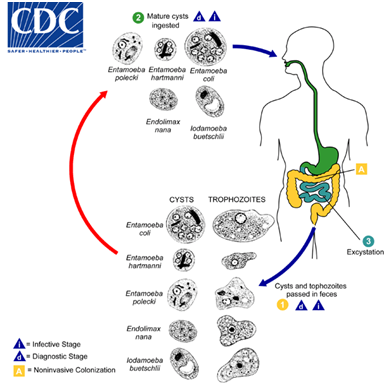Entamoeba polecki on:
[Wikipedia]
[Google]
[Amazon]
''Entamoeba polecki'' is an intestinal Parasitism, parasite of the genus ''Entamoeba''. ''E. polecki'' is found primarily in pigs and monkeys and is largely considered non-pathogenic in humans, although there have been some reports regarding symptomatic infections of humans. Prevalence is concentrated in New Guinea, with distribution also recorded in areas of southeast Asia, France, and the United States.

https://web.stanford.edu/group/parasites/ParaSites2004/Entamoeba/Entamoeba%20Polecki.htm
{{Taxonbar, from=Q3536119
Conosa
Parasites of mammals
Parasitic amoebozoa
Morphology
Mature trophozoites of ''E. polecki'' are generally 10-20 μm in diameter. Trophozoites are irregularly shaped and possess pseudopodia for motility. They have a single nucleus with a small central karyosome and finely dispersed peripheral chromatin, similar to that of ''Entamoeba histolytica''''.'' Cytoplasmic contents are similar to other ''Entamoeba'' sp. and are usually granular and vacuolated. Cysts of ''E. polecki'' are morphologically unique, containing only one nucleus, varyingly sized chromatoid bars, and a large inclusion mass.
Transmission & Life Cycle
There are two stages in the life cycle of ''E. polecki.'' The first is as a trophozoite, a vegetative stage that cannot survive in the environment. The second is a cyst, where transmission of parasite is possible and provides protection to harsh external environments. Cysts are infective when ingested by another organism. '' ''The cystic form of this protozoan has a diameter as small as 9.5 µm and as large as 17.5 µm. Morphologically, ''E. polecki'' is extremely similar to ''Entamoeba histolytica'' and ''Entamoeba hartmanni.'' Transmission follows a fecal-oral route. Infected feces with mature cysts are ingested where the cyst matures to the trophozoite in the gastrointestinal tract of the host. It is considered to be a Zoonosis, zoonotic parasite, as close contact with infected swine have been reported to be the cause of ''E. polecki'' infections in humans. Transmission to humans from consumption of pork is unlikely. Recent studies suggest that different subspecies infect non-human primates and pigs, and close inhabitation between the two do not coincide with transmission.Pathology
''E. polecki'' is considered to be Nonpathogenic organisms, non-pathogenic in humans. Symptom, Nonspecific symptoms from infection have been reported, including nausea, vomiting, diarrhea, bloody stools, and fever. Prevalence of infection amongst swine may be up to 25% across the world, but tend to be asymptomatic.Diagnosis and Treatment
Examination of stool samples for uninucleated cysts and trophozoites have been used for diagnosis. This method is not always reliable due to morphological similarities between ''E. polecki'' and other ''Entamoeba'' species. More recent diagnostic methods utilizing Gene duplication, DNA amplification and comparison have been used to better differentiate amongst pathogenic and species such as ''E. histolytica'' and non-pathogenic species. A definitive diagnosis can be made by using ELISA, electroimmunotransfer blots. Serological testing is not accurate between species of ''Entamoeba''. Treatment of infection is similar to that of other ''Entamoeba'' infections. Anti-parasitic medications such as metronidazole and ornidazole are generally used to treat human infections. Combination therapies such as metronidazole and Diloxanide, diloxanide furoate have been effective as well.References